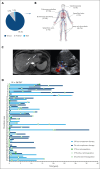Paroxysmal nocturnal hemoglobinuria-related thrombosis in the era of novel therapies: a 2043-patient-year analysis
- PMID: 38513233
- PMCID: PMC11830967
- DOI: 10.1182/blood.2024023988
Paroxysmal nocturnal hemoglobinuria-related thrombosis in the era of novel therapies: a 2043-patient-year analysis
Abstract
Thrombophilia is one of the principal features of paroxysmal nocturnal hemoglobinuria (PNH) and constitutes the main cause of disease morbidity/mortality. Anticomplement treatment has revolutionized the natural history of PNH, with control of the hemolytic process and abolition of thrombotic events (TEs). However, no guidelines exist for the management of thromboembolic complications in this setting, with type and duration of anticoagulation depending on individual practices. Besides, a scarcity of data is present on the efficacy of direct oral anticoagulants (DOACs). Herein, we accrued a large real-world cohort of patients with PNH from 4 US centers to explore features, predictors of TE, and anticoagulation strategies. Among 267 patients followed up for a total of 2043 patient-years, 56 (21%) developed TEs. These occurred at disease onset in 43% of cases, involving more frequently the venous system, typically as Budd-Chiari syndrome. Rate of TEs was halved in patients receiving complement inhibitors (21 vs 40 TEs per 1000 patient-years in untreated cases, with a 2-year cumulative incidence of thrombosis of 3.9% vs 18.3%, respectively), and varied according to PNH granulocytes and erythrocytes clone size, type, disease activity parameters, as well as number (≥2 mutations, or less) and variant allelic frequency of PIGA mutations. Anticoagulation with warfarin (39%), DOACs (37%), and low-molecular weight heparin (16%) was administered for a median of 29 months (interquartile range [IQR], 9-61.8). No thrombotic recurrence was observed in 19 patients treated with DOACs at a median observation of 17.1 months (IQR, 8.9-45) whereas 14 cases discontinued anticoagulation without TE recurrence at a median time of 51.4 months (IQR, 29.9-86.8).
© 2024 American Society of Hematology. Published by Elsevier Inc. All rights are reserved, including those for text and data mining, AI training, and similar technologies.
Conflict of interest statement
Conflict-of-interest disclosure: The authors declare no competing financial interests.
Figures




Comment in
-
Thrombosis in PNH: largely gone, but not forgotten.Blood. 2024 Jul 11;144(2):125-126. doi: 10.1182/blood.2024024660. Blood. 2024. PMID: 38990536 No abstract available.
References
-
- Waheed A, Shammo J, Dingli D. Paroxysmal nocturnal hemoglobinuria: review of the patient experience and treatment landscape. Blood Rev. 2024;64 - PubMed
-
- Weitz IC. Thrombosis in patients with paroxysmal nocturnal hemoglobinuria. Semin Thromb Hemost. 2011;37(3):315–321. - PubMed
-
- Weitz IC. Thrombosis in paroxysmal nocturnal hemoglobinuria - insights into the role of complement in thrombosis. Thromb Res. 2010;125:(suppl 2):S106–107. - PubMed
-
- Luzzatto L, Gianfaldoni G, Notaro R. Management of paroxysmal nocturnal hemoglobinuria: a personal view. Br J Haematol. 2011;153(6):709–720. - PubMed
Publication types
MeSH terms
Substances
Grants and funding
LinkOut - more resources
Full Text Sources
Medical

